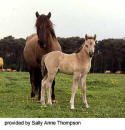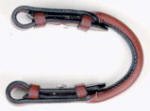
- Dulmen - |
|||
|
Germany is definitely more
famous for its warmblood breeds than for its pony breeds, and only
has one native pony remaining - the Dulmen. The Senner pony of the
Teutoburg Forest was the only other German pony breed, and it is
now considered extinct. The Dulmen is a very old breed that was
found near the town of Meerfelder Bruch, and area where ponies have
been documented since the early 1300s. The exact origins of the
breed are not known, although it is likely to have developed from
primitive horses, and still has some primitive characteristics. These ponies used to live
in large, wild herds all across Westphalia, but during the 19th
century as land was divided up and separated, the ponies began to
lose their natural habitat. Today there is only one wild herd left.
It is owned by the Duke of Croy, and roams approximately 860 acres
of the Meerfelder Bruch. The Dukes of Croy have had a long relationship
with the Dulmen pony and first helped the herd back in the middle
of the 19th century. Within the Meerfelder Bruch acreage there is
a wide diversity of small habitats ranging from woodland to open
moorland. These provide the ponies
with every environment they may need. They are left to lead a wild
lifestyle and must forage for their own food and seek out shelter,
and cope with illness and death. The members of the herd that survive
are subsequently the strongest and therefore, as a breed, they are
very tough and resistant to disease. Once a year, on the last Saturday
in May, the ponies are rounded up and the colts are separated. The
colts are then sold at public auctions and the mares are returned
to the Meerfelder Bruch with one or two stallions. Dulmen ponies that are
tamed and trained make excellent children's ponies and adapt to
civilized life very well. They are also useful driving ponies and
were used for working the land, maintaining their inordinate hardiness,
which they keep even in captivity. They are quite primitive looking
with coarse features. Some of them retain the dun coat coloring
while others exhibit brown, black, or chestnut coats, which indicates
infusions of foreign blood throughout the breed's past. They tend
to stand between 12 and 13 hh.
Bit Converter
Jr. Grooma Groomer |
|||
|






